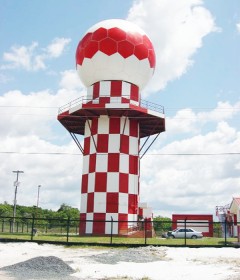–public education on radar
The $550 million Doppler Radar facility at the Cheddi Jagan International Airport (CJIA) which will provide up-to-the minute weather information is almost complete and is expected to be commissioned in October.

Plans are also afoot to have local television stations and media houses provided with weather information in order to sensitise the viewing public about the usefulness of the facility.
This was disclosed by Minister of Agriculture Robert Persaud who addressed members of the media during a tour of the facility yesterday. Persaud stated that the facility will be operated on a 24-hour basis by the 12-member staff of the Hydrometeorological Department of the Ministry of Agriculture, who will be relocated from their present location on the ground floor of the Air Traffic Control Tower to the radar site.
German scientist Dr Jens Didszun, who along with a team of engineers has been testing the system, said that the facility is capable of providing 400km of weather coverage centred around its present geographical location and giving updates every 15 minutes of weather conditions for a 24-hour period. While displaying images of weather conditions recorded earlier, he said the facility gives area, velocity and rainfall conditions. Colour-coded features on the radar screens will provide the forecaster with information about the different speeds at which the wind is blowing, with the sophisticated feature here being the provision of local wind profile.
As regards the facility’s integration with other regional facilities, Dr Glendel De Souza, a Trinidadian scientist, who is the project’s scientific and technical coordinator, noted that the facility will transmit information every 15 minutes to other Caribbean Meteorological Organization (CMO) member states including Suriname, Trinidad, Barbados, French Guiana, Martinique and a mother station in Guadeloupe. He said the latter will process data received from those stations and will redistribute full coverage of information received, giving a wider outlook of weather conditions within the Caribbean.
De Souza also stated that if the system were to shut down, such as in the case of a scheduled repair period, it will fall out of the ‘loop’ of regional facilities. He noted, however, radar facilities in nearby French Guiana as well as in other neighbouring countries provide coverage for parts of Guyana, thus this overlap will keep the system updated. Weather conditions of previous hours will be archived by this state-of-the-art facility so that at any given time in the long run, those weather conditions can be visited for reference.
De Souza also said that the system is so designed that any given area, such as Lethem or Georgetown, can be pinpointed and the weather conditions at that specific area can be observed.
Persaud noted that this is especially important for the aviation sector.
De Souza went on to state that the unit will target vulnerable areas such as villages along the coastland and as an example, he noted that whenever cricket is being played in Guyana, weather conditions for days of play can be predicted.
However, he said it would be up to the Hydro Met staff members to act on weather conditions predicted, so that accurate information could be provided to the public. In this regard De Souza, like Persaud, noted that public awareness, such as providing information to local TV stations, is being advocated.
The facility, which is being manned by a two-member maintenance crew, consists of three cabinets containing a transmitter, receiver and a control unit, these pieces of equipment are monitored by two computers. Weather information obtained by the system will be processed then disseminated to respective recipients.
Persaud said the facility will be provided with adequate security since he noted that it is a critical national resource.
He said that this will be supported by surveillance security features which are important where the well-being of staff is considered. As regards the facility and its importance, Persaud stated that the system will serve national needs such as weather alerts for persons living in low lying areas, the aviation sector and farmers.
To this end, he stated that major stakeholders such as the Civil Defence Commission, the Security Forces and the general public, including students, will benefit from the services of the facility.
The Doppler Radar Tower is an EU/Government of Guyana-funded project and when officially commissioned, the facility will put Guyana on par with Belize, Barbados, and Trinidad and Tobago among other countries.
After some initial setbacks, the project got off the ground and staff are currently being trained to man the facility.





